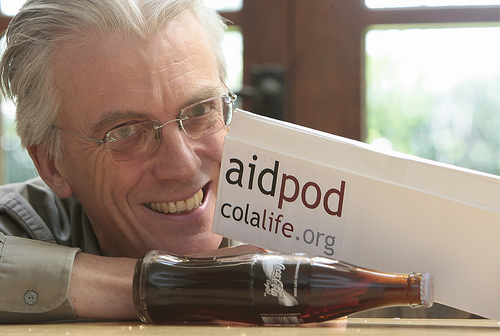Not too long ago, we talked about the importance of social products as part of the marketing mix. For review, the marketing mix is made up of the four p’s: product, price, promotion, and place. In the world of social marketing and social change initiatives, the “promotion p” has been stealing the spotlight for quite a while. This is why I want to highlight this amazingly wonderful place social marketing strategy–Meet ColaLife.
httpv://www.youtube.com/watch?v=z8gqgZQPS28
ColaLife, is a non-profit that is lobbying Coca-Cola to leverage its worldwide distribution channels to provide social products that help sustain life and improve public health. How exactly? –With some creative packaging in the form of “Aidpods.” With the help of these aidpods, Cola Life hopes to help achieve the following three goals:
- Reduce child mortality in developing countries (= UN Millennium Development Goal #4)
- Improve maternal health (= UN Millennium Development Goal #5)
- Combat HIV/AIDS, Malaria and other diseases (= UN Millennium Development Goal #6)
 You can read more about the organization’s aims and objectives, but overall, I think the idea is brilliant. At just about any public health conference I’ve been to, someone always references Coca-Cola as having the classic place (distribution) marketing strategy. Now, that same strategy can actually be leveraged to make a difference. There’s just one hitch…
You can read more about the organization’s aims and objectives, but overall, I think the idea is brilliant. At just about any public health conference I’ve been to, someone always references Coca-Cola as having the classic place (distribution) marketing strategy. Now, that same strategy can actually be leveraged to make a difference. There’s just one hitch…
Coca-Cola, or a similar corporate organization, has to sign on first. ColaLife has already had a successful trial of the program in Tanzania, and currently it’s focusing on spreading awareness of the project and gaining influence by talking with stakeholders and reviewing the strategy and overall plan. If interested, here’s five ways we can help:
- Follow @colalife on Twitter.
- Become a fan of the initiative on Facebook.
- Create your own aidpod.
- Watch the potential of this project by viewing ColaLife’s online videos.
- Donate.
Take away: This is one example of using a place strategy to do social marketing and in effect, create social change for the better. Thought: What distribution channels currently exist in your community that can be leveraged for social good?


